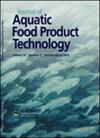Effects of Rosemary Extract and Chlorogenic Acid on Lipid and Protein Oxidation in the Sous Vide Processed Large Yellow Croaker Fillet Product During Cold Storage
IF 1.3
4区 农林科学
Q4 FOOD SCIENCE & TECHNOLOGY
引用次数: 0
Abstract
ABSTRACT Large yellow croaker fish fillets were sous vide processed and stored at 2°C for 4 weeks. Rosemary extract and chlorogenic acid were used to inhibit the lipid and protein oxidation. Rosemary extract and chlorogenic acid could significantly reduce levels of peroxide value (45% and 60%) and thiobarbituric acid reactive substances (39% and 47%) at the end of storage. Rosemary extract and chlorogenic acid reduced the carbonyl content by 40% and 51%, respectively, during storage but not the sulfhydryl loss during the sous vide processing step. Phenol–protein interaction needed to be studied further for quality improvement/evaluation in the future.KEYWORDS: Lipid oxidationprotein oxidationlarge yellow croakerrosemary extractchlorogenic acid Disclosure statementNo potential conflict of interest was reported by the author(s).Additional informationFundingThis work was supported by the Fund of Engineering Research Center of the Modern Technology for Eel Industry, Minister of Education, P.R. China No. [RE202318].迷迭香提取物和绿原酸对低温处理大黄鱼鱼片中脂质和蛋白质氧化的影响
对大黄鱼鱼片进行真空烹调处理,并在2℃下保存4周。用迷迭香提取物和绿原酸抑制脂质和蛋白质氧化。迷迭香提取物和绿原酸能显著降低贮藏末过氧化值(45%和60%)和硫代巴比妥酸活性物质(39%和47%)水平。迷迭香提取物和绿原酸在贮藏过程中分别降低了40%和51%的羰基含量,但在真空烹调过程中没有降低巯基的损失。酚-蛋白相互作用需要进一步研究,以便将来进行质量改进/评价。关键词:脂质氧化蛋白氧化大黄鱼迷迭香提取物绿原酸披露声明作者未报告潜在利益冲突本研究得到教育部鳗鱼产业现代技术工程研究中心基金(No. 1)的支持。[RE202318]。
本文章由计算机程序翻译,如有差异,请以英文原文为准。
求助全文
约1分钟内获得全文
求助全文
来源期刊
CiteScore
3.50
自引率
6.20%
发文量
77
审稿时长
7 months
期刊介绍:
The Journal of Aquatic Food Product Technology publishes research papers, short communications, and review articles concerning the application of science and technology and biotechnology to all aspects of research, innovation, production, and distribution of food products originating from the marine and freshwater bodies of the world. The journal features articles on various aspects of basic and applied science in topics related to:
-harvesting and handling practices-
processing with traditional and new technologies-
refrigeration and freezing-
packaging and storage-
safety and traceability-
byproduct utilization-
consumer attitudes toward aquatic food.
The Journal also covers basic studies of aquatic products as related to food chemistry, microbiology, and engineering, such as all flora and fauna from aquatic environs, including seaweeds and underutilized species used directly for human consumption or alternative uses. Special features in the journal include guest editorials by specialists in their fields and book reviews covering a wide range of topics.

 求助内容:
求助内容: 应助结果提醒方式:
应助结果提醒方式:


